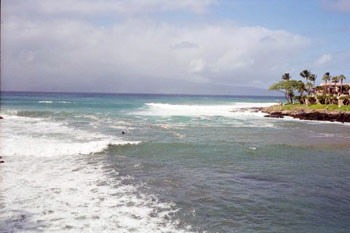
by Denise Rogers
It used to be a shorter trip or so it seemed — having a meal served then watching a movie — six hours passed quickly. Now it feels like an interminable amount of time.
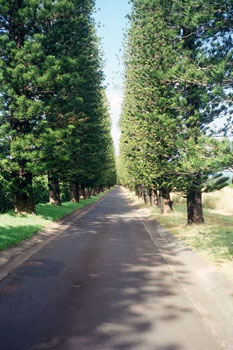 Is it worth it? Oh yes. We land, retrieve our luggage and walk out into the sunshine. The Trade winds are blowing; those wonderful, gentle breezes that caress the palm trees and carry the scent of plumeria, just one of the many flowers that grow in the Islands. I can feel my body letting go of all the stressors. We are back on Maui.
Is it worth it? Oh yes. We land, retrieve our luggage and walk out into the sunshine. The Trade winds are blowing; those wonderful, gentle breezes that caress the palm trees and carry the scent of plumeria, just one of the many flowers that grow in the Islands. I can feel my body letting go of all the stressors. We are back on Maui.
Our time is spent doing absolutely nothing. No agendas, no schedules and no appointments. We wake up to the sound of tropical birds coo-cooing, eat our breakfast which always includes sweet, yellow papaya, go for a walk either through the magnificent Norfolk pines or along the ocean, return to our condo, maybe read, have lunch on the lanai, drive into Lahaina to shop for dinner, perhaps rent a movie then go to bed. We do the same thing pretty much every day in what we call “Paradise”. There are no nasty bugs and dangerous critters in Hawaii. We also like being in the good old US of A in case we need medical attention.
 One of the highlights of our trip is driving to upcountry Maui on the slopes of the now dormant volcano, Haleakala. Every time we make the trip it feels like a new adventure. We are never bored by the scenery – the sugar cane and pineapple fields, the red earth, the rows of hibiscus and the sea below where earlier we had just squished the wet sand between our toes.
One of the highlights of our trip is driving to upcountry Maui on the slopes of the now dormant volcano, Haleakala. Every time we make the trip it feels like a new adventure. We are never bored by the scenery – the sugar cane and pineapple fields, the red earth, the rows of hibiscus and the sea below where earlier we had just squished the wet sand between our toes.
Our destination is the Kaluanui Estate – a former sugar plantation and home built by the Baldwins, one of the missionary families. Here Ethel Baldwin invited friends to come and create art. The estate is now the Hui No’eau, a Visual Arts Center and Gallery.
Maui has become our second home and just like Bali Hai in the musical “South Pacific,” it “whispers in the wind of the sea, here am I, your special island. Come to me, come to me.” A hui hou.
If You Go:
♦ There are non-stop flights from Vancouver to Maui return via West Jet or Air Canada. You could also fly out of Bellingham, WA.
♦ Accommodations vary from hotels to condos depending on your needs. We prefer the north west side of the Island, Napili. Kaanapali is just next door then a short drive takes you to the old whaling town, Lahaina. If you want a more arid, desert experience then stay at the south end in Wailea or Kihei. Check the website: www.gohawaii.com/maui
Maui Tours Now Available:
West Maui Whale Watching and Snorkeling Excursion
Full-Day Maui Tour: Road to Hana Tour
Myths of Maui Luau Dinner and a Show

Maui Day Trip: Haleakala, Iao Valley, Old Lahaina from Oahu
About the author:
Denise Rogers’ background is in training and development and adult education. She edited professional journals, company newsletters, designed training manuals and contributed to a column in the Burnaby NewsLeader. While creating art with children in various programs for the City of Burnaby, she was inspired to write and publish her first picture book; Today is the Day to Run Away. See: www.bigtoepublishing.com
Photo credits:
All photographs are by Denise Rogers.

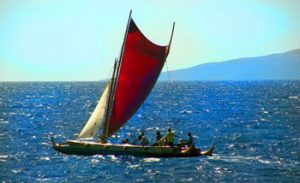
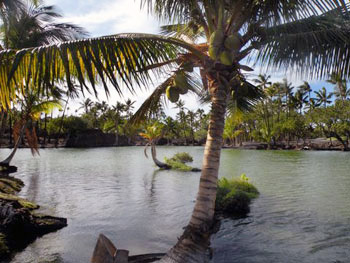 My wife Annie and I are immersing ourselves in the history and culture of Hawaii’s less crowded “outer” shores, far from the lights and traffic of Waikiki. It is like opening a Russian doll, so many hidden dimensions are revealed. We keep getting vivid glimpses of long-vanished ways of life. It is a rich, diverse and sometimes shocking tableau, full of extreme contrasts. On the one hand, there is the fondly imagined paradise of dramatic geography, a sultry climate and beautiful native people. On the other, a history of brutal warfare and the oppressive traditional social system, in which commoners might be killed for stepping on the king’s shadow. On the Big Island, however, people were safe if they reached sanctuary within the walls and temples of the City of Refuge, now painstakingly restored.
My wife Annie and I are immersing ourselves in the history and culture of Hawaii’s less crowded “outer” shores, far from the lights and traffic of Waikiki. It is like opening a Russian doll, so many hidden dimensions are revealed. We keep getting vivid glimpses of long-vanished ways of life. It is a rich, diverse and sometimes shocking tableau, full of extreme contrasts. On the one hand, there is the fondly imagined paradise of dramatic geography, a sultry climate and beautiful native people. On the other, a history of brutal warfare and the oppressive traditional social system, in which commoners might be killed for stepping on the king’s shadow. On the Big Island, however, people were safe if they reached sanctuary within the walls and temples of the City of Refuge, now painstakingly restored.
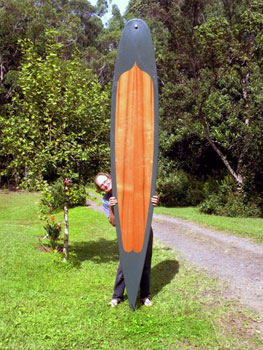 Also surprising is how rapidly Hawaii changed after Captain Cook arrived in 1778. By the 1820s, Lahaina was a bustling center for whalers and missionaries, with grog shops and churches, brothels and hotels. That was fully two decades before the Gold Rush led to the growth of San Francisco. In fact, Lahaina had America’s first high school west of the Mississippi. Since then, entire industries, such as pineapple cultivation, have come and gone, vanishing almost entirely. Great forests of koa and sandalwood were pillaged for export. Where fields of sugar cane flourished until quite recently, there are now virtual ghost towns and abandoned mills.
Also surprising is how rapidly Hawaii changed after Captain Cook arrived in 1778. By the 1820s, Lahaina was a bustling center for whalers and missionaries, with grog shops and churches, brothels and hotels. That was fully two decades before the Gold Rush led to the growth of San Francisco. In fact, Lahaina had America’s first high school west of the Mississippi. Since then, entire industries, such as pineapple cultivation, have come and gone, vanishing almost entirely. Great forests of koa and sandalwood were pillaged for export. Where fields of sugar cane flourished until quite recently, there are now virtual ghost towns and abandoned mills.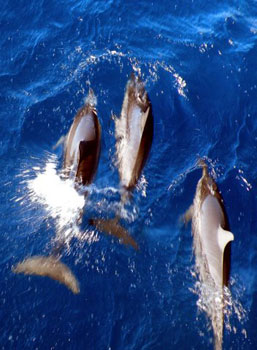 Then, we join a cruise that starts at the Big Island and ends on Maui. Carrying around 30 passengers, the
Then, we join a cruise that starts at the Big Island and ends on Maui. Carrying around 30 passengers, the 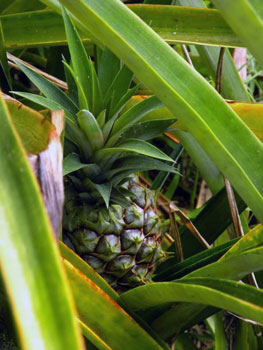 Other evenings, special guests come on board. A hula troupe gives a performance that is nothing like what tourists experience at most resorts and commercial luaus. The lead dancers are men. They do aggressive, warlike steps, much like the Maori haka in New Zealand, rather than gentle, flowing ones. The moves are accompanied by chanting and drumming. There is not a ukelele or guitar in sight. We join them in drinking awa, a mildly narcotic ceremonial potion known elsewhere in the Pacific as kava. Another night, we meet Lawrence Aki, a hulk of a man who exudes quiet dignity, and his young disciple Kawika. Lawrence is a kumu (teacher) from a remote valley on Molokai. Kawika has lived with him for five years, helping at first in the taro patch and learning the old ways. This includes speaking the Hawaiian language and reciting genealogies. “It’s a lifetime commitment,” Lawrence says.
Other evenings, special guests come on board. A hula troupe gives a performance that is nothing like what tourists experience at most resorts and commercial luaus. The lead dancers are men. They do aggressive, warlike steps, much like the Maori haka in New Zealand, rather than gentle, flowing ones. The moves are accompanied by chanting and drumming. There is not a ukelele or guitar in sight. We join them in drinking awa, a mildly narcotic ceremonial potion known elsewhere in the Pacific as kava. Another night, we meet Lawrence Aki, a hulk of a man who exudes quiet dignity, and his young disciple Kawika. Lawrence is a kumu (teacher) from a remote valley on Molokai. Kawika has lived with him for five years, helping at first in the taro patch and learning the old ways. This includes speaking the Hawaiian language and reciting genealogies. “It’s a lifetime commitment,” Lawrence says.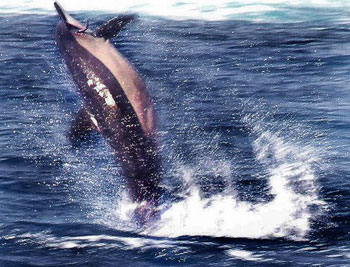 The final morning, a humpback leaps in the distance. It is a fitting sendoff. We have an entire afternoon to enjoy before a midnight flight home, and we have decided to visit a small museum about Pacific whaling. It features the old tools and equipment and the many products produced from an estimated 292,000 great cetaceans killed by the American fleet alone between 1825 and 1872. Fortunately, the humpbacks have made a remarkable recovery in recent years, from a low of around 1,000 in the 1960s to 20,000 or more today. On display outside is the impressive skeleton of a 40-foot sperm whale.
The final morning, a humpback leaps in the distance. It is a fitting sendoff. We have an entire afternoon to enjoy before a midnight flight home, and we have decided to visit a small museum about Pacific whaling. It features the old tools and equipment and the many products produced from an estimated 292,000 great cetaceans killed by the American fleet alone between 1825 and 1872. Fortunately, the humpbacks have made a remarkable recovery in recent years, from a low of around 1,000 in the 1960s to 20,000 or more today. On display outside is the impressive skeleton of a 40-foot sperm whale.
